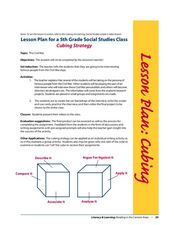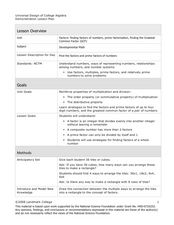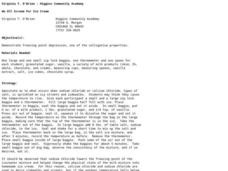Curated OER
Opening a Special Ed Class
This is not just a lesson plan, it's a life saver! Here are 10 separate documents intended to assist a new Special Ed teacher. There are 4 different games, instructional tips, ways to handle documentation, behavioral modification...
Curated OER
Cubing Strategy
Fifth graders interview each other in the role of civil war personalities. In this Civil War lesson, 5th graders create a script and video of an interview with classmates who are portraying characters from the Civil War. Students are...
Pennsylvania Department of Education
Volume and Surface Area
Build boxes using unit cubes to compare surface area and volume. The group performs multiple experiments to determine properties of volume, such as if it makes a difference which order the dimensions are multiplied in. Extensive...
West Contra Costa Unified School District
Adding by finding 10's
Count with ten frames in a first grade addition lesson. Kids determine how to identify numbers on a number line, as well as with ten frames, and complete ten frames to show their answers in several addition problems.
Curated OER
Brog-Cube-the Spam
A Middle school special ed class uses the acronym SPAM to learn the 4 parts of writing. They employ 4 different colors to help them visually distinguish each part of writing in a given prompt. This lesson is vague and uses a strong...
Curated OER
Volume of Solid Figures
Learners calculate volume using the correct formula and the correct unit. They explore different prisms, spheres, cubes, and cones as they calculate volume and relate it to depths in oceans.
Curated OER
The Lightning Thief: Questioning Strategy
Step into the shoes of the Oracle from the novel, Percy Jackson and the Olympians: The Lightning Thief by Rick Riordan, with this response to reading activity. After reading chapter nine, scholars answer questions from the Oracle's point...
Curated OER
An Introduction To Volume
Upper graders explore the topic of volume. In this math lesson plan, pupils count volume in cubic units, multiply to find volume, estimate volume, write a multiplication sentence to find the volume, and make a cost analysis of different...
Pennsylvania Department of Education
Comparing Sets
Students count back with cubes to model subtraction problems. In this subtraction lesson plan, students compare sets of problems and record their results in a table.
Curated OER
America's Civil Rights Movement, Cubing
Learners explore cubing as a graphic organizer to better explain the key concepts of the Civil Rights Movement and take positions on key concepts regarding the Movement.
Curated OER
Find the Factors and Prime Factors
Show the class how to find the factors of numbers. They use a variety of strategies, including unifix cubes, to find the factors of a whole number. This resource includes clear procedure to follow. Included are an anticipatory set,...
Curated OER
Calorimetry
Students investigate calorimetry and set up equipment to measure calories. In this calorimetry lesson plan, students make a calorimeter and compare large amounts of heated water with small amounts to show the difference in calories....
Curated OER
Movement Across the Membrane (Diffusion)
Students investigate the concept of diffusion and how materials enter and leave a cell. In this movement across a membrane lesson plan, students use perfume, food coloring in water and a sugar cube in water to observe diffusion. They...
Curated OER
Diffusion
Students investigate diffusion using different solutions of chemicals placed in agar dishes. In this diffusion lesson plan, students observe 3 demonstrations of diffusion using perfume, food coloring in water and sugar cubes in water....
Curated OER
What Happens When You Eat?
Students explore digestion. In this Human Body lesson plan, students participate in six different activities pertaining to the Digestive System. Students gain understanding of digestion through experimentation and investigation. Students...
Curated OER
Cell Size and Division or How Big Would You Want To Be if You Were a Cell?
Students investigate why cells divide. In this cell size lesson plan, students observe how far a solution travels into 3 different size model cells of agar. They answer questions about the most effect movement of "nutrients" into the...
Curated OER
Polymer
Students investigate polymers by completing 3 experiments. In this polymer lesson plan, students mix plastic with acetone, they create polyurethane foam, they make slime and build a polymer model once their polyurethane foam is set. ...
Curated OER
Weather
Fifth graders study the water cycle. In this science lesson plan, 5th graders distinguish among evaporation, condensation, and precipitation phases of the water cycle.
Curated OER
Density-Qualitative and Quantitative
Students investigate density using film canisters filled with different density materials and larger objects of varying density. In this density lesson plan, students discuss the concept of density and rank film containers from dense to...
Curated OER
We All Scream for Ice Cream
Young scholars investigate the freezing point depression of water while making ice cream. In this colligative properties lesson plan, students make ice cream using ice, salt and water to freeze milk and sugar. They measure the...
Curated OER
Rate of Solubility
Students investigate factors affecting the rate of solubility. In this rate of solubility lesson plan, students experiment by crushing, heating and cooling solutes and solvents to see how the solubility is affected. For each situation,...
Curated OER
States of Matter For Grades Kg-8
Students conduct studies of states of matter. In this science lesson plan, students observe the properties of matter and classify different substances as solids, liquids, and gases.
Curated OER
States of Matter
Student explore states of matter. In this science lesson plan, students define matter, identify the states of matter, tell about the properties of each state of matter, and demonstrate an understanding of the difference between a...
Curated OER
Math Lesson Study Plan
Second graders find missing addends by solving math word problems. In this missing addend lesson, 2nd graders work in a whole group setting to find the missing addends in word problems before using the strategies to work independently....

























